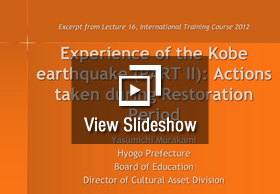

This section emphasises creating links between recovery and mitigation stages within the disaster risk management framework. It lays special emphasis on the significance of capacity building in post disaster recovery planning. It also emphasizes identifying available human resources and evaluating their skills, and supplementing them with the required technical ability needed to respond to disaster risks and potential disaster scenarios.
This content also summarises the lessons from this module and is a useful tool for participants who may often be heritage managers or administrators of institutions in charge of administration of heritage.
A detailed lecture is essential at this stage to inform the participants on the various approaches of linking post disaster recovery mechanisms to mitigate risks for the future. It should stress on using the experience of a disaster to equip heritage managers and other stakeholders to protect their cultural heritage from future damage due to disaster. It should also illustrate how capacity building and training are essential components of the disaster risk management process in general and that post disaster recovery can be used an opportunity to build capacities aimed at reducing risks from future disasters. It may be linked with a lecture on community participation as well, in modules 3 and 4 during the course.
Training of heritage managers for post disaster recovery of cultural heritage, International Training Course, 2011
Instructor: Yasumichi Murakami
Duration: 80 minutes (continuation of previous lecture)
Read More...


Training of heritage managers for post disaster recovery of cultural heritage, International Training Course, 2011
Instructor: Yasumichi Murakami | Duration: 80 minutes (continuation of previous lecture)
Using a running case study of the Hanshin Awaji Earthquake, various actions undertaken for long term mitigation of risks to cultural heritage were illustrated to participants. The training of heritage managers as a means of human resource development and capacity building was also highlighted. This lecture is a continuation of the lecture given in the previous sub-modules. It highlights the training programmes initiated by Hyogo Prefecture for capacity building after the earthquake.
Actions after the Earthquake
The lecture linked the recovery process to mitigation from future disasters through:
A disaster mitigation system could be established through the process in which post disaster recovery is linked to risk mitigation through following actions:
The instructor also used the example of, the Hyogo Prefecture Board of Education’s initiative to develop human resources through capacity building.
The project was intended to equip heritage managers with specific skills related to undesignated buildings such as:
Within this lecture, the instructor also highlighted how capacity building was an integral part of recovery and mitigation. He emphasised that with the increasing importance of the role of heritage managers, the number of inquiries from cities, towns, and private organisations has been steadily growing within Japan.

